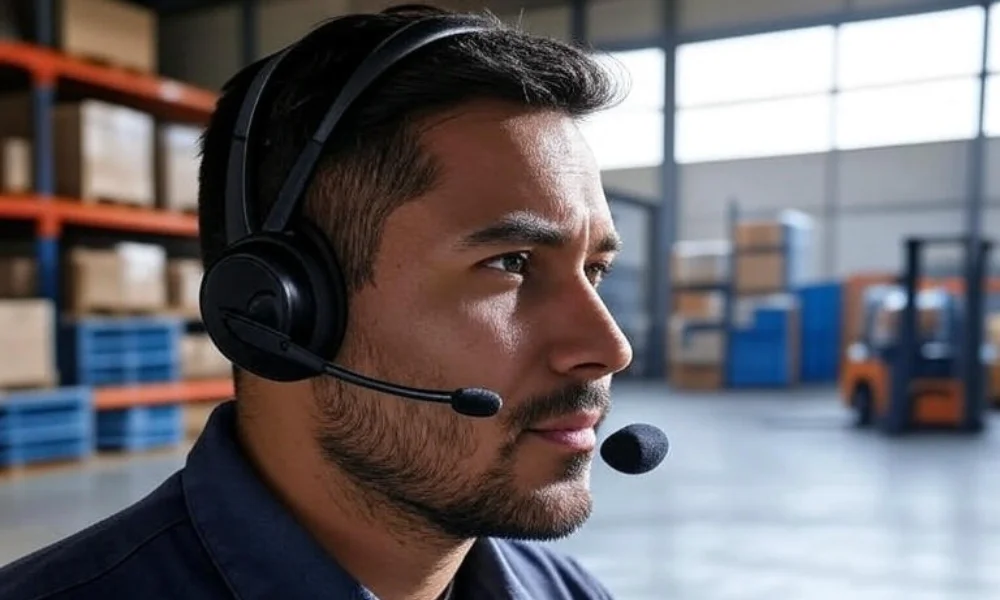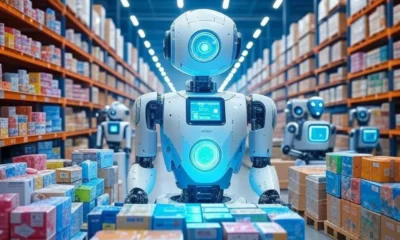Artificial Intelligence
Natural Language Processing (NLP) for Voice-Directed Warehousing:

Have you ever wanted your warehouse to work faster, without anyone needing to hold a paper list? It was my impression from the beginning when I found out about voice-directed warehousing. It seemed exciting that workers would be able to ask the system and get instant instructions. One of the first things I learned as someone interested in warehouse automation is that Natural Language Processing (NLP) drives everything.
Definition:
Natural Language Processing makes it possible for computers to understand people through their voices and respond well.
NLP assisted voice commands allow me to complete tasks more quickly, limit mistakes and keep workers focused in the warehouse. Because voice systems with NLP function hands-free and allow real-time guidance, they are very useful in modern warehouses. Because delivery expectations have risen so much, I believe it has made these enhancements more necessary than ever.
In this blog post, I’ll explain how Natural Language Processing helps in voice directed warehousing, make the AI warehouse benefits clear and point out the reasons U.S. companies are adopting it. If you want to know how artificial intelligence can simplify, speed up and improve work in warehouses read on.
What does Natural Language Processing (NLP) involve?
- Initially, I didn’t realize that NLP played a role beyond being used by tech companies in smart assistants. While learning more about warehouses, I saw that NLP greatly helps make voice commands on the warehouse floor much easier. We want to develop not only understanding, but actually useful and accurate voice control for real jobs.
- Without NLP, smart voice systems would not recognize what I say when I ask them for help or pick a specific location. It hears what I say, works out the message and offers a clear reply, quite fast, using my voice.
- NLP comes to life mostly because of the way it handles three basic functions.
- Speech Recognition lets the system change speech into text it can process.
- It works out what my intended meaning was.
- Persons get answers back as voice directions I can follow right away.
- I use NLP in things like Alexa and Siri at home, but it’s even more helpful in my warehouse. During my work picking or moving items, I wish I didn’t have to press buttons. Because of NLP, I can voice my thoughts as I move, without stopping to listen to instructions.
- It is possible for warehouses to work more quickly and efficiently because they only have to talk to the technology the same way they communicate with coworkers.
What is Voice-Directed Warehousing?
- I recall entering a warehouse for the first occasion and noticing all the employees with clipboards, scanning barcodes relentlessly. I noticed that it didn’t feel up to date and traveled slowly. That was when I understood what a difference voice-directed warehousing could make. Now, workers wear headsets and communicate with an AI as they work.
- System tells me what to do and how to do it by voice throughout the entire process. When I am given the instruction “Ready,” System points me to my next target and explains what I need to do. It makes me pay attention and keep both hands open during my work.
- This is how voice-directed warehouse management compares to working with traditional methods.
- Before: Using printed sheets and looking at them along with scanning barcodes.
Voice way:
- Real guidance right when you need it after every step.
- Using Virgin Zoom takes the chaos out of my workflow by allowing me to hear and respond to anyone attending a call. Because it’s hands-free and eyes-free, it makes warehouse operations easier and more efficient.
- This can all happen thanks to Natural Language Processing. With NLP, the system can easily grasp my directions and answer right away. In places with lots of background sound and activity, voice systems wouldn’t understand users without NLP.
Voice-directed warehouse systems depend on NLP technology:
- I often asked myself how voice commands could hear my words through all the noise of the machines. What makes it happen is Natural Language Processing. It turns my speech into parts that the system reads out fast and correctly.
- Here’s the routine I follow when working on a picking request:
- I say “Start picking,” and the system uses a headset to capture what I say.
- NLP recognizes what I want—to start a particular task.
- It informs me that I should go to B-17 location and pick up five boxes.
- After I say “Confirm” the task is ticked off and the next one is sent to me.
- What stood out to me is how great NLP is at filtering out background noise. They are set up so that forklifts, fans and other noises from the warehouse won’t be recognized. Whatever I tell them, it stays easy to understand even when the noise level goes up.
- Multilingual support is also a big plus of the platform. Some of the teams I’ve worked with are made up of people from different communities, some of whom do not speak English as their first language. We can speak or write in various ways through NLP and still achieve good results. The software’s flexibility allows training to be simpler and communication to be more effective.
- Advancements in smart voice interaction would not be possible without NLP always learning from how people communicate in real life.
How does NLP benefit warehouses?
After using voice-directed systems supported by NLP, I immediately saw that my work changed for the better. I found that tasks flowed better and I didn’t have to interrupt my work for lists or scanning things. NLP helped me keep my productivity high all through the day.
This is what stuck out to me once I looked:
- Freedom to Move, I could move freely, not needing to hold documents or scanners which made my work faster.
- NLP helped my system understand better what I was saying which reduced errors.
- Instead of reading many documents, new hires picked up the system rapidly simply by talking and listening.
- We all appreciated how safe the area was. I didn’t have to stop and read the instructions which helped me focus on everything happening around me. Because of this, it became safer to work in highly active areas and near forklifts.
- I also didn’t expect that the job would be so much simpler than I’d thought. Not pushing buttons all the time made me feel less stressed during the day. Noticing others experience the same benefits helped me see that NLP is working in the warehouse.
- There’s more to it than just making things easier—these methods allow warehouses to fulfill their delivery schedules and customer orders more consistently.
What problems can NLP create or limit in warehouse settings?
- While NLP has helped me in many ways in the warehouse, I’ve encountered some problems with it. Systems will always have issues, so knowing what might go wrong is important before using voice-directed methods.
- My biggest problem was identifying different accents. A number of systems had difficulties with words when spoken using different accents. This situation also meant team members from various backgrounds had to wait longer.
- People complained about loud background noise as well. Warehouses are noisy and even with improvements, NLP has trouble processing information at its busiest moments. When it doesn’t recognize what I said, it repeats the wrong command or makes me repeat my request.
- Down periods of technical issues can cause further delay to work. If the server behind the voice system or NLP breaks down, I’m unable to respond to requests. I have often watched a full shift wait until tech teams repair issues with software or restart the servers. Such delays get us down when we are busy.
- Lastly, there’s the expense of setting up the company. Putting such systems in place needs money, preparation and time. Sometimes, smaller businesses struggle when they first try to pay for warehouse management software.
- Many companies face these issues by adopting specialized mics, offering workers language classes and making offline backups. Though these solutions are good, I think there is still potential for the industry to improve.
Which issues come up when applying NLP in warehouses?
- While NLP has helped me a lot in the warehouse, I’ve encountered some issues as well. Voice directed workflows aren’t perfect and it helps to know about any problems they might cause before using them.
- I found that accent recognition was the biggest obstacle for me. It was common for some systems to have trouble with words that are pronounced differently than usual. So, team members from diverse backgrounds encountered more delays.
- The researchers also found that background noise posed another problem. Warehouses can be very loud and even with NLP’s new AI tools, it struggles at the busiest moments. Sometimes, if the system misunderstands me, it sends a different task or has me say it again.
- Issues with the network’s hardware and equipment are a further problem users must face. If I’m unable to use the voice system or my NLP engine, I’m not very useful. There have been times when tech teams had to stop the entire shift to handle problems. It’s very frustrating when this takes place when everything is busy.
- Costs don’t end with monthly rates; there’s also the cost to set up the account. Installation of voice-directed systems using NLP involves both financial investment and a learning process. For some, getting a warehouse for their small shop is out of reach at the beginning.
- To deal with these concerns, numerous companies use specially made microphones, teach workers new languages and create backups that don’t require internet. Using these methods helps, although I think it’s still possible for the industry to get better.
What is the future of NLP in warehousing?
- Since my job is to use voice-directed systems regularly, I often consider what the future of NLP in warehousing will look like. The industry keeps making progress and I am eager to see what will come next in tech. Things will come about where systems respond more thoughtfully, act faster and communicate more like humans.
- I anticipate soon being able to talk with NLP as I would a friend. Rather than using common phrases, I can simply ask, “I’ve finished aisle four, what’s my next stop?” and the system will know what I need. Having that interaction will make things quicker and easier to understand.
- AI personalization is also expected to play a bigger role in future sales. Each worker’s communication style will affect how the NLP system is built and improved. Accent and speech are used less often in mistakes, making things better for all users. I expect it will result in warehouse teams that are both diverse and inclusive.
In my opinion, here’s what is likely to become more common:
- Today, team members can communicate in real time across different languages.
- Task suggestions are made based on how staff carry out their work and what they have accomplished before.
- Ability to issue orders to automated machines using voice commands through warehouse robots.
- When customer needs reach new heights and warehouses get busier, NLP will be a vital need. With each use, I notice more and more ways tech is transforming logistics routines each day.
Conclusion:
Prior to trying out voice-directed systems, using the warehouse was both slow and boring. When I learned about how NLP made those systems more intelligent, it all became very different for me. Work became less stressful, I completed tasks faster and using NLP made my job safer for me.
Because I could tell my phone what to do, NLP made it unnecessary for me to use paper lists and keep looking them up over and over. I felt more free and less distracted, making me get my tasks done faster. The evidence shows that voice-directed warehousing will be a key part of the logistics industry in the future.
NLP-powered voice systems can make your operations run smoother, save you time on training and make your team’s work experience better, so they’re a solid investment. I’ve personally noticed these benefits and I expect many more American warehouses to start using this technology ahead. Have you ever dealt with voice systems before? How did you feel about it?How could NLP help your warehouse to improve? Don’t be shy; leave a comment or share what you’ve learned in this post with others!
-

 Artificial Intelligence8 months ago
Artificial Intelligence8 months agoHow to Use Grok AI: A Complete Guide
-

 Artificial Intelligence10 months ago
Artificial Intelligence10 months agoWhat is Artificial Intelligence? A Comprehensive Guide for Businesses and Enthusiasts
-

 Artificial Intelligence9 months ago
Artificial Intelligence9 months agoUnlocking the Power of Artificial Intelligence Tools
-

 Artificial Intelligence9 months ago
Artificial Intelligence9 months agoWhat is DeepSeek? Revolutionizing AI with Cutting-Edge Solutions
-

 Artificial Intelligence5 months ago
Artificial Intelligence5 months agoAI Technologies in Warehouse Automation:
-

 Artificial Intelligence5 months ago
Artificial Intelligence5 months agoPredictive Analytics for Demand Forecasting:
-

 Artificial Intelligence6 months ago
Artificial Intelligence6 months agoMeta’s AI Push: The Standalone Assistant App Set to Rival ChatGPT
-

 Artificial Intelligence5 months ago
Artificial Intelligence5 months agoHow Artificial Intelligence is Revolutionizing Logistics:



sprunkiy.com
05/22/2025 at 5:35 PM
Great read! For those who love music and creativity, the Sprunki mod brings fresh beats and visuals to Incredibox, making it a must-try for fans and newcomers alike.
subway surfers
05/24/2025 at 6:58 PM
The addictive loop in Subway Surfers taps into our brain’s love for instant rewards-coins, power-ups, and near-misses keep players hooked. It’s no wonder Subway Surfers Games remains a top pick for casual runners everywhere.